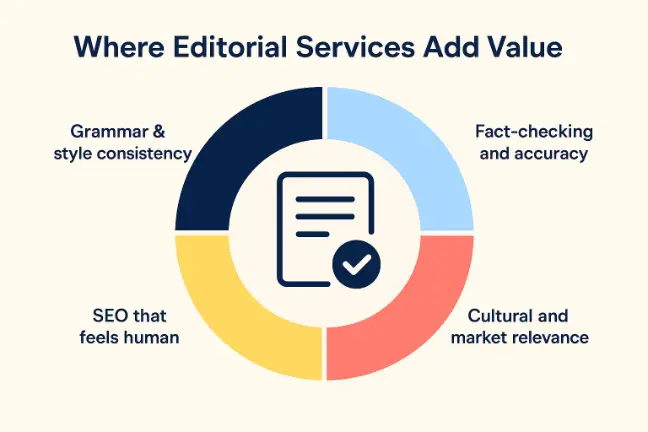In today’s B2B marketing landscape, speed often gets more attention than quality. With AI tools churning out content in seconds and brands racing to flood LinkedIn feeds, it’s easy to think volume equals visibility. But here’s the catch: audiences (and algorithms) can tell the difference between content that’s rushed and content that’s refined.
That’s where editorial services step in. From polishing grammar to ensuring strategic alignment, editorial quality control remains the unsung hero of successful B2B content marketing. Whether you’re publishing thought leadership, product explainers, or long-form reports, the difference between “just another blog” and “credible industry insight” often lies in the editorial process.
So why does quality control still win in 2025, and how can B2B brands use editorial services to strengthen their content marketing strategy? Let’s break it down.
Why Editorial Quality Control Is Non-Negotiable in B2B Marketing
When your audience is other businesses, the stakes are higher. You’re not just selling a product; you’re selling trust, expertise, and reliability. A sloppy sentence or inconsistent fact doesn’t just hurt readability, it undermines credibility.
Here’s what’s at risk without editorial oversight:
- Brand Reputation: Typos in a whitepaper signal carelessness.
- SEO Performance: Poor structure and keyword misuse weaken search visibility.
- Compliance Risks: In sectors like finance or healthcare, unchecked errors can cause regulatory issues.
- Lost Opportunities: Decision-makers don’t have time for unclear or inconsistent messaging.
In B2B content marketing, editorial services aren’t just about grammar, they’re about brand protection and audience trust.
What Do Editorial Services for B2B Content Marketing Include?
Modern editorial services go beyond proofreading. They integrate quality control, SEO alignment, and brand consistency to ensure every piece of content contributes to your long-term strategy.
Core components include:
- Proofreading: Eliminating typos, grammar slips, and formatting errors.
- Editing: Refining flow, tone, and clarity while improving structure and logic.
- Fact-checking: Verifying stats, data, and claims to strengthen authority.
- SEO Optimisation: Aligning with semantic keywords, internal linking, and metadata best practices.
- Style Consistency: Applying brand voice, preferred English variant (UK/US), and formatting guides.
- Compliance Checks: Ensuring content aligns with industry regulations and disclosures.
Think of it as the quality filter that ensures your B2B marketing isn’t just “content,” it’s a reliable representation of your expertise.
The Hidden ROI of Editorial Quality in B2B Content
It’s tempting to view editorial services as a “nice-to-have.” After all, AI and content writers can produce text quickly. But quality control delivers measurable ROI in ways many brands overlook.
1. Better Engagement & Recall
Content that’s clear, structured, and engaging keeps readers on-page longer, reducing bounce rates.
2. Higher Search Rankings
Editorially polished content naturally performs better with semantic SEO, because search engines favour readability and authority.
3.Stronger Conversion Rates
Well-edited case studies, brochures, and landing pages communicate trust, which is essential in high-ticket B2B decisions.
4. Reduced Legal & Compliance Risks
Editorial checks catch ambiguous language or missing disclaimers before they cause problems.
Editorial Services vs. AI-Generated Content: The Balance
With the rise of generative AI tools, many B2B marketers wonder: do we still need editorial teams? The short answer: absolutely.
AI is excellent for first drafts, brainstorming, and scaling volume, but it lacks the contextual judgment required for B2B. Editorial services bridge the gap by:
- Verifying Accuracy: AI can fabricate stats, editors catch and correct them.
- Refining Tone: B2B messaging needs precision, empathy, and authority, qualities editors specialise in.
- Structuring for SEO: Editors know how to weave LSI keywords, internal links, and metadata naturally.
- Adding Cultural Nuance: Especially for global firms, localisation requires human insight.
The future isn’t AI vs. editors, it’s AI + editorial quality control.

Source: Inkorporated
Common B2B Content Problems Editorial Services Solve
1. Inconsistent Messaging
Multiple writers often mean inconsistent tone. Editors unify brand voice.
2. Poor Readability
Overly complex language alienates readers. Editors simplify without dumbing down.
3. Keyword Stuffing
Some content teams still overuse keywords. Editors optimise for semantic strategy instead.
4. Data Without Context
Throwing numbers into content without explaining relevance weakens impact. Editors add narrative flow.
5. Lack of Internal Linking
Editors ensure blogs, whitepapers, and case studies connect for stronger SEO and user journeys.
Where Editorial Services Fit in the B2B Content Lifecycle
Editorial input isn’t just the last step before publishing, it should be built into the content lifecycle:
- Strategy Phase: Editors ensure messaging aligns with brand goals and audience personas.
- Drafting Phase: Early editorial reviews catch structure issues before they multiply.
- Pre-publication: Proofreading, SEO checks, and compliance reviews.
- Post-publication: Reviewing engagement metrics and updating content for accuracy.
This continuous loop turns editorial services into a growth lever, not just a quality checkpoint.
7 Trends Shaping Editorial Services in 2025
1. AI-Human Collaboration Becomes the Norm
AI tools can now generate drafts, suggest edits, and flag grammar inconsistencies in seconds. But in 2025, the winning formula isn’t AI alone, it’s the blend of machine efficiency and human judgment. Editors are stepping in to refine tone, ensure brand alignment, and inject emotional resonance where AI still falls short.
2. SEO Moves Beyond Keywords to Search Intent & EEAT
Search engines increasingly reward content that demonstrates Experience, Expertise, Authoritativeness, and Trustworthiness (EEAT). Editorial teams now ensure every piece of content not only reads smoothly but also matches real search intent, incorporates expert insights, and builds credibility. Micro-Localisation Gains Ground
3. Micro-Localisation Gains Ground
For B2B firms working across regions, it’s no longer enough to “translate” content. Editorial services in 2025 focus on micro-localisation, tailoring tone, terminology, and even visuals for specific geographies, industries, or buyer segments. This prevents embarrassing errors and boosts resonance with niche audiences.
4. Data-Driven Editing with Engagement Analytics
Editorial teams are tapping into heatmaps, scroll-depth trackers, and A/B tests to see where readers drop off. This allows editors to shape more impactful introductions, sharper calls-to-action, and content structures optimised for reader retention. Proofreading isn’t just about grammar anymore, it’s about performance editing.
5. Accessibility and Inclusive Language Standards
Global B2B firms can’t afford to alienate readers. Editorial services now systematically check for inclusive language, accessibility compliance (like WCAG), and clarity for non-native English readers. This ensures content speaks to the broadest audience possible without compromising professionalism.
6. Visual Editorial Integration
With the rise of infographics, short-form video, and carousel content, editorial services now extend beyond text. Editors are reviewing scripts, captions, and visuals to ensure consistency of story and message. Words and design are treated as one storytelling package rather than separate silos.
7. Regulatory Alignment as Editorial Responsibility
In regulated industries (finance, healthcare, energy), editorial teams are becoming compliance gatekeepers. Fact-checking now includes aligning with disclosure norms, data privacy laws, and industry-specific guidelines, reducing legal risks and safeguarding brand reputation.
Final Take: Why Quality in B2B Content Still Wins
In B2B marketing, volume may get you seen, but quality gets you remembered. Editorial services provide the polish that separates a credible thought leader from just another content generator.
By investing in editorial quality control, B2B firms can:
- Safeguard credibility
- Improve SEO and discoverability
- Increase engagement and conversions
- Reduce compliance risks
- Build long-term trust with audiences
The message is clear: in an era of AI-generated noise, quality-controlled content is your competitive edge. Ready to elevate your B2B content with editorial precision that drives trust, compliance, and conversions? Let’s talk.

